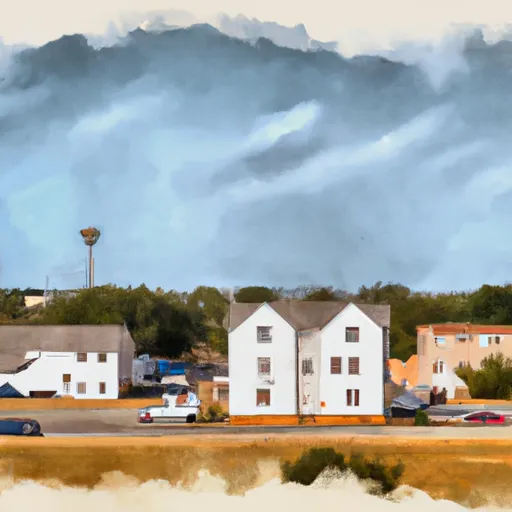-
 Snoflo Premium
Snoflo Premium
Get unlimited access to all our content
With no Ad interruptions! - Start Your Free Trial Login with existing account
Winifred
Eden Index
Climate
8.1
•
Recreation
•
Community
1.9
•
Safeguard
3.7/10

Winifred, Kansas is a small town located in Chautauqua County in the south-central region of the state. The town experiences a humid subtropical climate characterized by hot summers and mild winters. Average high temperatures in the summer months (June to August) range from 85°F to 95°F, while average lows during winter (December to February) range from 20°F to 30°F. The region receives an average annual precipitation of around 40 inches, with rainfall spread throughout the year.
Winifred is situated near the Elk River, which provides hydrological opportunities for residents and visitors. The river is known for its diverse fish population, making it a popular spot for fishing enthusiasts. Additionally, the river offers opportunities for canoeing, kayaking, and boating.
For outdoor recreation, Winifred and its surrounding areas boast several nature trails and parks. Chautauqua State Fishing Lake offers hiking trails and camping facilities, making it an ideal spot for nature lovers and outdoor enthusiasts. The region is also home to the Chautauqua Hills Trail System, which provides miles of scenic hiking and biking trails through picturesque landscapes and woodlands.
In summary, residents and visitors of Winifred, Kansas can enjoy a humid subtropical climate, abundant outdoor recreation opportunities, and access to the Elk River and Chautauqua Hills Trail System for various hydrological and nature-based activities.
What is the Eden Index?
The Snoflo Eden Index serves as a comprehensive rating system for regions, evaluating their desirability through a holistic assessment of climate health, outdoor recreation opportunities, and natural disaster risk, acknowledging the profound impact of these factors on livability and well-being.
Climate Health Indicator (CHI): 8.1
Winifred receives approximately
845mm of rain per year,
with humidity levels near 84%
and air temperatures averaging around
12°C.
Winifred has a plant hardyness factor of
5, meaning
plants and agriculture in this region thrive during a short period during spring and early summer. Most
plants will die off during the colder winter months.
By considering the ideal temperature range, reliable water supplies, clean air, and stable seasonal rain or snowpacks, the Climate Health Indicator (CHI) underscores the significance of a healthy climate as the foundation for quality living.
A healthy climate is paramount for ensuring a high quality of life and livability in a region, fostering both physical well-being and environmental harmony. This can be characterized by ideal temperatures, reliable access to water supplies, clean air, and consistent seasonal rain or snowpacks.
Weather Forecast
Streamflow Conditions
Big Blue
Area Rivers
Big Blue
Snowpack Depths
Big Blue
Reservoir Storage Capacity
Big Blue
Groundwater Levels
Recreational Opportunity Index (ROI):
The Recreational Opportunity Index (ROI) recognizes the value of outdoor recreational options, such as parks, hiking trails, camping sites, and fishing spots, while acknowledging that climate plays a pivotal role in ensuring the comfort and consistency of these experiences.
Access to outdoor recreational opportunities, encompassing activities such as parks, hiking, camping, and fishing, is crucial for overall well-being, and the climate plays a pivotal role in enabling and enhancing these experiences, ensuring that individuals can engage in nature-based activities comfortably and consistently.
Camping Areas
| Campground | Campsites | Reservations | Toilets | Showers | Elevation |
|---|---|---|---|---|---|
| Rockford Lake State Rec Area | 107 | 1,390 ft | |||
| Eugene T. Mahoney State Park | 150 | 1,167 ft | |||
| Tuttle Creek State Park | 700 | 1,027 ft | |||
| Burchard Lake State Wildlife Area | 10 | 1,336 ft | |||
| Stockdale - Tuttle Creek Reservoir | None | 1,157 ft | |||
| Feits Memorial Park | 15 | 1,228 ft | |||
| Tuttle Creek Cove - Tuttle Creek Lake | 55 | 1,183 ft | |||
| Oregon Trail RV Park | 16 | 1,182 ft | |||
| Marysville City Park | None | 1,144 ft |
Catastrophe Safeguard Index (CSI):
The Catastrophe Safeguard Index (CSI) recognizes that natural disaster risk, encompassing floods, fires, hurricanes, and tornadoes, can drastically affect safety and the overall appeal of an area.
The level of natural disaster risk in a region significantly affects safety and the overall livability, with climate change amplifying these risks by potentially increasing the frequency and intensity of events like floods, fires, hurricanes, and tornadoes, thereby posing substantial challenges to community resilience and well-being.
Community Resilience Indicator (CRI): 1.9
The Community Resilience Indicator (CRI) recognizes that education, healthcare, and socioeconomics are crucial to the well-being of a region. The CRI acknowledges the profound impact of these elements on residents' overall quality of life. By evaluating educational resources, healthcare accessibility, and economic inclusivity, the index captures the essential aspects that contribute to a thriving community, fostering resident satisfaction, equity, and social cohesion.

